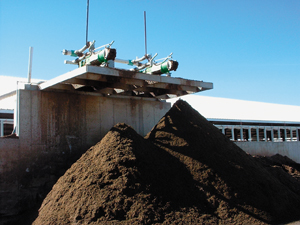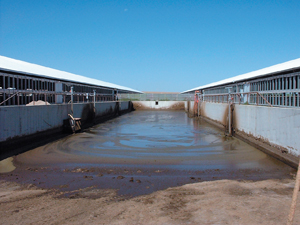
The Visser family moved its
dairy farm from Southern California to Idaho, and had to build its new
operation from scratch, including the manure management system.
The Visser family moved its dairy farm from Southern California to Idaho, and had to build its new operation from scratch, including the manure management system.
In 2000, Jerry Visser was operating the family farm in Southern California, in Chino Valley, approximately 40 miles outside of Los Angeles. The farm had three locations, all about 40 acres in size, one with 1,000 cows, one with 800 and the last with 600.
Farming in the valley had been growing increasingly difficult. The spreading of manure in the valley had been curtailed, and regulations required that it be trucked off site. “Those last couple years in the valley we were trucking it anywhere from 30 to 150 miles away to get rid of it,” recalls Visser.
And it wasn’t just the regulations. People were moving in and the area was developing rapidly.
 Today, the Visser operation houses 2,500 cows in free stall barns and outside dry corrals. Jerry Visser (center) with son Brad (left), and Jamie Greenlea, owner/operator of Greenlea Dairy Construction. Today, the Visser operation houses 2,500 cows in free stall barns and outside dry corrals. Jerry Visser (center) with son Brad (left), and Jamie Greenlea, owner/operator of Greenlea Dairy Construction. |
The Vissers knew that to keep the operation going they would have to make some drastic changes—first and foremost, moving the farm out of Chino Valley. After looking around, they purchased 2,400-acres in Buhl, Idaho (30 miles west of Twin Falls), which would become Eagle View Farms. But it would be some time before they could put the cows on trucks and head north. It was raw land and the farm would need to be built from the ground up.
“It took a year to go through the planning and permit process,” says Visser. “We broke ground early in 2001. Then we spent most of that year in construction.” The Vissers initially built a milk barn as well as two free stall barns, each 1,400 feet in length. Between the two barns, they put in a cement manure pit, roughly 300 feet by 65 feet, with a two million gallon capacity. They added more cows and today house 2,500 cows in the free stall barns and 1,200 in dry corrals outside.
“We had a vacuum system when we originally built the barns, but it was just too much of a maintenance problem,” says Visser. “We were also hauling manure from the pit to other farms and their needs were changing. It wasn’t going to work anymore. So we had to go to a different kind of system.”
It was at the World Ag Expo that the Vissers saw the Bauer display, thought it might meet their needs, and decided to research it further. “They came up here and explained what they could do and what they had and we decided to go with them,” says Visser.
It was a three-month transition from the vacuum system to the Bauer system.
First they had to make modifications inside the free stall barns so that the manure could be scraped into troughs by a skid steer and gravity fed into the existing cement pit.
“It took a little extra effort, since we had to work around the cows,” says Jamie Greenlea, owner/operator of Greenlea Dairy Construction. “But we managed okay.”
Once the manure from the free stalls, along with the water from the milk barn, is collected in the pit, it is agitated by six SMX 17 hp Bauer submersible mixers each pushing 630,000 gallons a minute.
 With the system in place at Eagle View Farms, a Bauer S11, 15 hp submersible pump pushes 400 gallons a minute through two 850 separators with a .75 mill screen. The solids are placed into windrows for composting and the With the system in place at Eagle View Farms, a Bauer S11, 15 hp submersible pump pushes 400 gallons a minute through two 850 separators with a .75 mill screen. The solids are placed into windrows for composting and the liquid pumped into the lagoons. |
Then a Bauer S11, 15 hp submersible pump pushes 400 gallons a minute through two 850 separators with a .75 mill screen. And finally, the solids are placed into windrows for composting and the liquid pumped into the lagoons.
“We use the compost for bedding,” say Visser. “It takes about four months to compost because it takes a while for it to dry out. Once we get this cycle going where we have enough bedding, we’ll be able to take the manure straight out [to neighboring farms] instead of composting.”
Visser has had no problem finding neighbors who will spread the manure; in Idaho, farmers can spread solids year round. “Where we are there are a few big farmers and really no dairies in the immediate area. They’ve been happy to get the manure from us.”
As for the liquids, they are pumped into two lagoons—each 600 feet by 800 feet and about 10 to 12 feet deep. They aren’t lined, but are instead made of compacted clay that meets Idaho’s environmental standards.
“Dairymen may come out of California to Idaho to get away from regulations, but that’s just not the case,” says Visser. “Actually, they’re stricter if anything. It’s kind of a common misconception. Idaho regulations are as strict or stricter than any in the country.”
Some of the liquids from the lagoon are also shipped to neighboring farms. The rest is spread on Eagle View fields through a pivot irrigation system. And Visser is able to spread the liquids from March 15 to November 15.
With a 2,400-acre farm, the first question that comes to mind is why ship to other farms with such a large area to spread. The answer is simple—the Vissers are only farming about 250 of those acres.
“The rest of the acres are in dry pastures,” explains Visser. “This farm was in the CRP—the Conservation Reserve Program—when I bought it. It’s a 10-year government program where the land is planted with natural grasses. The 10 years has run and I can start farming it, but I’m not doing the whole thing at once.”
 The Vissers initially built a milk barn as well as two free stall The Vissers initially built a milk barn as well as two free stallbarns, each 1,400 feet in length. Between the two barns, they put in a cement manure pit, roughly 300 feet by 65 feet, with a two million gallon capacity. Manure in the pit is agitated by six SMX 17 hp Bauer submersible mixers. |
The barns and the new Bauer system are working well. And Visser is continuing with the expansion the family had envisioned when they first came to Idaho. In fact, they have just finished the second milk barn, this time adding some high tech elements.
“The milking and wash system are now run through a computer,” says Visser. “It counts the number of cows through the barn, controls the water flushing on the floors and the alleyways and decks. It’s all timed.”
They are also in the process of finishing the construction of two additional free stall barns, each 700 feet long, as well as an additional cement storage pit.
This pit will be half the size, with a one million gallon capacity. And an identical Bauer system is being installed, except there will be fewer mixers needed.
This is to prepare for the addition of more cows. Eagle View intends to go from milking 3,700 to 5,000 by spring 2005, with a total of 5,000 milk cows and 5,000 dry heifers by mid-year.
Jamie Greenlea, who has been working with the Vissers from the start, has enjoyed the process and his customer: “I couldn’t pick better people to do trials with and work with. Jerry doesn’t just want the system to work; he wants what’s right for his dairy. We all work as a team. We sit down and talk it out. He knows where he wants to go and I know what I need to do.”
It’s the Visser family’s flexibility, ingenuity, and willingness to try new things—whether it is moving an operation, building from scratch, or trying new technology—that has allowed them to thrive. This year, it will be 50 years since Jerry’s dad started the farm, milking 120 cows. Since 1955, change has been just a part of the way the Vissers do business.
“It has been a gradual growth process through the years,” explains Visser. “You just kind of add people as you need to and go to the next step.”
Currently the farm employs 40 people and the Vissers take their responsibility as employer seriously. “They talk about family farms, but I like to say our family owns it, but we support 40 families,” says Visser. And Eagle View is likely to be supporting families in the community for some time to come, as both of Jerry’s adult sons, Bradley and Russell, look like they will be carrying the family enterprise.
Despite all the changes—especially moving from sunny, warm Southern California to Idaho—the Vissers don’t seem be experiencing much, if any, culture shock. “When we came to Idaho, we thought it would be quite a bit different, but everybody likes it here. It’s a different lifestyle—a little slower. And it’s not so crowded. We don’t want to go back.”